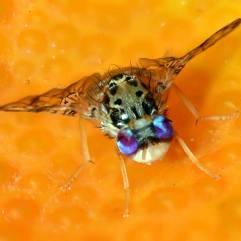13 August 2014. Researchers at the biotechnology company Oxitec Ltd. in Oxford and University of East Anglia in Norwich, both in the U.K., created a modified form of the Mediterranean fruit fly that tests show can reduce the population of this pest responsible for extensive crop damage in many parts of the world. Results of the research from the team that includes colleagues in Greece, where field work was conducted, appear online today in the journal Proceedings of the Royal Society B.
Mediterranean fruit fly, known by the short-hand term medfly, infests more than 300 wild and cultivated fruits, vegetables, and nuts worldwide. Damage from medflies affects crops in southern Europe, Middle East, Australia, Pacific Islands, Africa, Central and South America, Caribbean, and parts of the U.S. The pest is difficult to control, and techniques for containing or eliminating medflies — quarantines, baited traps, insecticides, and inflicting natural enemies on the species — return mixed results. Some of these techniques, such as traps and insecticides, can involve dangerous chemicals.
Yet another control method is the sterile insect technique that introduces forms of the male medfly into the population prevent further generations of the pest by producing weakened offspring that die off before maturity or only males. This technique also produces mixed results, with the radiation for generating the sterile forms believed to cause weakened medflies that cannot compete with stronger wild types.
The Oxitec/East Anglia team took a different approach to controlling medflies, creating a robust form of the male insect genetically-engineered to produce only male offspring. The technique, known as release of insects carrying a dominant lethal or RIDL, in this case adds a gene to the males where the RIDL is lethal only to females. Releasing these robust yet engineered male medflies into the wild population, therefore, should over time cause the wild medfly population to collapse.
The researchers tested this premise in greenhouses at University of Crete in Greece, having cages that simulated fruit orchards with a lemon tree and food and water sources. The team released into each cage a precise number of wild-type medflies in the pupal stage, between larva and adult. After 6 weeks, the researchers began releasing genetically engineered male medflies each week into half of the cages, with the other cages serving as controls.
The results show the cages with the modified males experienced declining numbers of wild medflies until the wild types disappeared. The researchers found after 6 weeks, production of eggs in the cages with the engineered males began declining. In addition, more males with the added female-lethal gene increased in the test cages, until the original wild-type form of medfly became extinct by about week 17. At the same time, the number of wild-type medflies in the cages without the modified males remained about the same.
Oxitec is now seeking approvals to carry out open-field studies with engineered medflies. The company develops RIDL-based solutions for medflies and other species: diamond back moth, pink bollworm, mexfly, and olive fly.
Read more:
- U.S. Energy, Ag Depts Fund Genomic Research for Biofuels
- Arcadia Awarded U.S. Patent for Longer Shelf-Life Tomato
- Biotech Partnership to Develop Non-Ricin Castor Plants
- Gene Modified Potatoes Developed with Blight Resistance
- Engineered Hemp Delivers High Volume of Healthy Oleic Acid
* * *


 RSS - Posts
RSS - Posts
You must be logged in to post a comment.